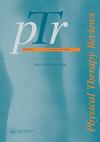Balance assessment tools and their psychometric properties among individuals post-stroke: a systematic review
IF 0.8
Q4 REHABILITATION
引用次数: 0
Abstract
Abstract Background and purpose Balance assessment following stroke is a significant part of the rehabilitation program. The Berg Balance Scale (BBS), the Postural Assessment Scale for Stroke (PASS) and the Balance Evaluation Systems Test (BESTest) are multi-item balance scales commonly used for assessing balance for people post-stroke. The purpose of our systematic review is to identify and appraise the literature on the psychometric properties of these balance measures (BBS, PASS and BESTest) in studies involving people post-stroke. Methods A comprehensive electronic literature search was performed in five databases PubMed, CINAHL, Embase, Scopus and Web of Science; in addition to hand searching of relevant references. Two independent reviewers screened the literature search results to include studies that were: written in the English language and published in peer-reviewed journals; participants were adults (>18 years) and had a diagnosis of stroke; Balance of participants was assessed using one (or more) of the following measures: BBS, PASS, BESTest or a shortened version of these measures; and the study reported at least one psychometric property for the balance measure. Two independent reviewers extracted the data using a standardized form. Quality of included studies was assessed using a critical appraisal tool. Results A total of 65 studies met our inclusion criteria and were included in our review. The majority of studies reported on the psychometric properties of the BBS, followed by the PASS and then the BESTest. Results of the critical appraisal scale showed that the overall quality of studies was good. A variety of psychometric properties were reported, with validity being the most reported property followed by reliability. Discussion The BBS, BESTest and PASS and their variants show overall excellent psychometric properties when used among people post-stroke. However, further research is needed to investigate the responsiveness of these measures following rehabilitation programs.平衡评估工具和他们的心理测量特性在个体中风后:一个系统的回顾
摘要背景和目的脑卒中后的平衡评估是康复计划的重要组成部分。Berg平衡量表(BBS)、中风姿势评估量表(PASS)和平衡评估系统测试(BESTest)是常用于评估中风后患者平衡的多项目平衡量表。我们系统综述的目的是识别和评价在涉及脑卒中后人群的研究中关于这些平衡测量(BBS、PASS和BESTest)的心理测量特性的文献。方法在PubMed、CINAHL、Embase、Scopus和Web of Science五个数据库中进行综合电子文献检索;除了手动搜索相关参考文献之外。两名独立评审员对文献搜索结果进行了筛选,以包括以下研究:用英语撰写并发表在同行评审期刊上;参与者为成年人(>18 年),并被诊断为中风;使用以下一项(或多项)指标评估参与者的平衡:BBS、PASS、BESTest或这些指标的缩短版;该研究报告了平衡测量的至少一个心理测量特性。两名独立评审员使用标准化表格提取数据。纳入研究的质量使用关键评估工具进行评估。结果共有65项研究符合我们的纳入标准,并被纳入我们的综述。大多数研究报告了BBS的心理测量特性,其次是PASS,然后是BESTest。批判性评价量表的结果表明,研究的总体质量良好。报告了各种心理测量特性,有效性是报告最多的特性,其次是可靠性。讨论BBS、BESTest和PASS及其变体在中风后人群中使用时显示出总体上优异的心理测量特性。然而,还需要进一步的研究来调查这些措施在康复计划后的反应性。
本文章由计算机程序翻译,如有差异,请以英文原文为准。
求助全文
约1分钟内获得全文
求助全文
来源期刊

Physical Therapy Reviews
REHABILITATION-
CiteScore
1.30
自引率
0.00%
发文量
26
期刊介绍:
Physical Therapy Reviews is an international journal which aims to publish contemporary reviews, discussion papers and editorials within physical therapy, and in those basic and clinical sciences which are the basis of physical therapy. The journal is aimed at all those involved in research, teaching and practice within the area of physical therapy. Reviews (both descriptive and systematic) are invited in the following areas, which reflect the breadth and diversity of practice within physical therapy: •neurological rehabilitation •movement and exercise •orthopaedics and rheumatology •manual therapy and massage •sports medicine •measurement •chest physiotherapy •electrotherapeutics •obstetrics and gynaecology •complementary therapies •professional issues •musculoskeletal rehabilitation
 求助内容:
求助内容: 应助结果提醒方式:
应助结果提醒方式:


